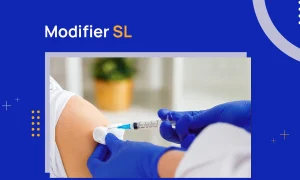Electrocardiography (ECG/EKG) is a fundamental test to ensure proper cardiac care. However, billing it is anything but straightforward.
Healthcare practitioners and facilities often struggle with subtle distinctions that dictate proper reimbursement. These challenges may range from distinguishing between global and component billing to precisely capturing repeat or distinct services. So, we can say that the path to timely reimbursements for electrocardiography services is quite bumpy.
But don’t worry. This guide will help you overcome all the billing roadblocks related to one such procedural code, i.e., CPT code 93000. Experts at NeuraBill have produced this guide to ensure you never get another claim denial due to misapplied modifiers, lack of medical necessity, or inadequate documentation.
So, without further ado, let’s start the discussion!
CPT Code 93000 – Description
Do you want to streamline your billing workflow and ensure accurate coding? If yes, understanding the code descriptor should be your priority!
CPT code 93000 represents tracing and recording the heart’s electrical activity using an electrocardiogram (ECG/EKG) with 12 leads. The healthcare provider performs the ECG test, interprets the results, and prepares a detailed written report with the findings.
For the unversed, wires connect the 12 electrodes/ leads (placed on different parts of the patient’s body) to the ECG machine.
Note: Medicare may not reimburse this procedure when you perform it as part of a routine physical examination or for screening purposes.
Appropriate Use Cases for CPT Code 93000
Now that you understand what the code descriptor covers, it is time to look at a few clinical scenarios where CPT 93000 applies:
Chest Pain Evaluation
Do you know that over 350,000 cardiac arrests occur outside of the hospital facility annually? In 2019 alone, there were 232,000 emergency department visits on average with cardiac arrest in the U.S. Moreover, chest pain is one of the most common reasons for which people visit the emergency department.
With that said, picture a scenario where a 63-year-old male patient is taken to the emergency department. He complains of sudden crushing chest pain that radiates to his left arm. Besides, he was experiencing heavy sweating and shortness of breath.
The healthcare provider orders a 12-lead ECG/EKG (CPT code 93000), suspecting an acute coronary syndrome. The ECG/EKG shows ST-segment elevations in the inferior leads, confirming an acute inferior heart attack (myocardial infarction). The physician interprets the report, detailing ECG abnormalities and their clinical significance, while immediately initiating the necessary cardiac intervention.
In the U.S., someone has a heart attack every 40 seconds. ECG/EKG is a critical procedure that helps identify and treat it before it is too late.
Workup for Palpitations and Dizziness
Consider a 47-year-old male patient who has been experiencing intermittent episodes of lightheadedness and palpitations (fluttering sensation in the chest) for the past few weeks. He visits his primary care physician. The provider orders a 12-lead ECG/EKG (CPT code 93000), suspecting a structural heart disease or cardiac arrhythmias.
For context, cardiac arrhythmias are a condition in which the heart beats too fast or too slow (irregular heartbeat). It is a prevalent health concern, as each year, 2.7 million individuals are diagnosed with it.
Now, back to the scenario! During the procedure, the technician performs the ECG/EKG tracing and prints the results. The physician interprets the results and generates a comprehensive report with the findings, which include occasional premature ventricular contractions (PVCs).
Congestive Heart Failure (CHF) Follow-Up
Alarmingly, almost 6.5 million individuals over the age of 20 have heart failure in the U.S. What’s more heart-wrenching is that every year, approximately 960,000 new cases of CHF are recorded. ECG/EKG is an integral procedure that cardiologists perform to check the heart’s function. The following scenario will offer clarity on how it helps.
Imagine a 71-year-old male patient with diagnosed CHF. He visits the clinic for a scheduled follow-up appointment with the cardiologist for an assessment of the medication’s efficacy and monitoring of cardiac status. Therefore, the cardiologist orders a 12-lead ECG (CPT code 93000) for comprehensive evaluation of the heart’s electrical activity.
The technician managed ECG tracing, and the cardiologist interprets the results and prepares the report. He compares the current ECG report with previous reports to determine changes in conduction abnormalities, chamber size, or signs of worsening heart function.
Modifiers to Append with CPT Code 93000
Discussed below are some of the applicable modifiers for CPT code 93000:
Modifier 59
It is another integral modifier that you should be aware of. You should append it when the same physician performs two distinct, separately identifiable procedures with it for the same patient on the same day.
For instance, the provider conducted a 3-lead ECG/EKG initially. However, the patient’s condition demanded clarity. Thus, later the physician performed a 12-lead ECG/EKG on the same patient, on the same day. Now, you will report the two procedures like this: 93040 and 93000-59.
Modifier 76
Assume a scenario where a patient came to the emergency department due to chest pain, and the healthcare provider decided to keep him under observation for a couple of hours. Due to the age and medical history, two ECGs/EKGs are conducted on the same day by the same provider.
When such circumstances occur, you should report the first electrocardiogram as 93000, and the next one as 93000-76. It will help avoid denial due to duplication error and ensure you receive reimbursement for both ECGs/EKGs.
Modifier 77
Now, what if the complete 12-lead electrocardiogram was repeated for the same patient on the same day, but by a different healthcare provider? For example, a patient was in the emergency room, and the physician performed an ECG/EKG. The reports came back normal, so he was discharged. However, later that night, he started experiencing shortness of breath, irregular heartbeat, and chest pain. As a result, the patient was brought back to the emergency department by a family member, and another provider conducted an electrocardiogram this time.
Here, you will report the second 12-lead ECG/EKG covered under CPT code 93000 with modifier 77.
Reimbursement Guidelines for CPT Code 93000
Discussed below are the billing requirements for a 12-lead ECG/EKG:
Documentation Requirements
Comprehensive documentation is integral when it comes to billing CPT code 93000. It also helps establish medical necessity for the rendered electrocardiography, which is an essential reimbursement requirement by payers. Thus, your documentation must include the following:
- Mention the patient’s symptoms that necessitated the need for a 12-lead ECG/EKG procedure.
- Include detailed patient history, and clearly state if the patient has any previous heart conditions or surgeries.
- Identify in the documentation the purpose for conducting the electrocardiography, i.e., monitoring or diagnostic.
- Attach the ECG/EKG tracing as well as a detailed report of the procedure, including abnormalities (if any).
Ensure Coding Accuracy and Specificity
CPT code 93000 is a global procedure, i.e., it covers both the technical and professional components of the 12-lead electrocardiogram. So, you should not append modifiers 26 and TC to this code. However, if you were only in charge of one component of the ECG, either its tracing or just the interpretation and reporting, then use another ECG code instead.
- 93005 – It covers only the technical component (tracing, equipment, supplies, other resources) of the 12-lead ECG/EKG.
- 93010 – It covers only the interpretation and reporting of the 12-lead ECG/EKG.
Append Appropriate Modifier for Special Circumstances
Modifiers are the gateway to capturing the nuances of charge capture that you would otherwise miss, leading to denials, delays, payment cuts, or uncompensated care. However, you should not use these two-digit codes to receive unfairly higher reimbursement. Otherwise, you get into trouble. It can result in audits, financial penalties, criminal charges, and reputational damage.
Some of the modifiers that apply to CPT 93000 are 59, 76, and 77. You can find out more details about their appropriate usage in the ‘Modifiers to Append with CPT Code 93000’ section.
Final Thoughts on CPT Code 93000
CPT code 93000 is an integral code for billing a common procedure, 12-lead electrocardiography. It covers both professional and technical components. Some modifiers that apply to it include 59, 76, and 77. The guidelines stated in this blog should be enough to report CPT 93000 accurately. However, if you still struggle, you can consider acquiring cardiology billing services from our billing specialists at NeuraBill.



